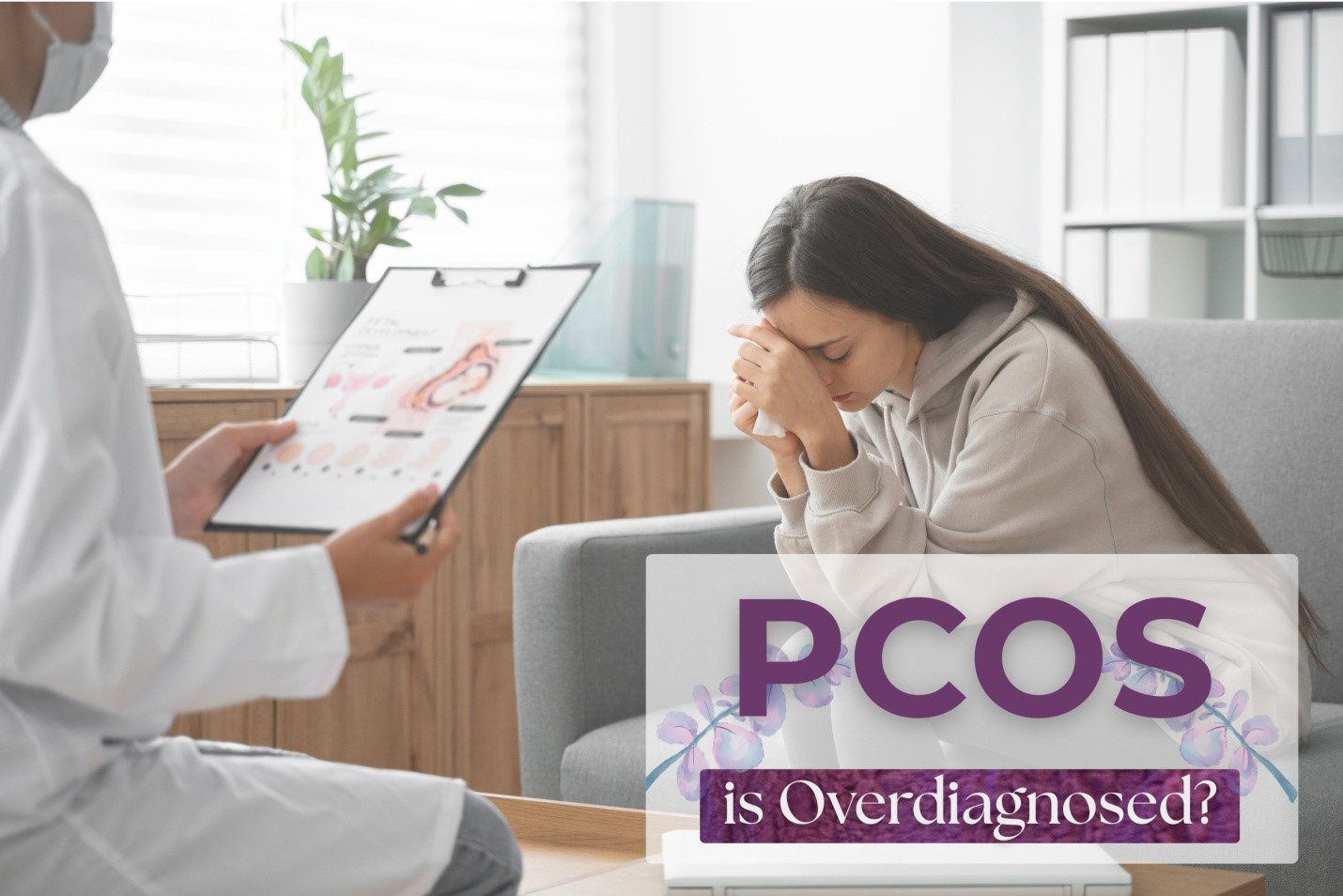Polycystic Ovary Syndrome (PCOS) is one of the most frequent endocrine conditions affecting women of reproductive age. However, despite its widespread occurrence, rising concerns draw attention to the PCOS is being overdiagnosed worldwide. Many young women receive the diagnosis of PCOS based on accidental ultrasound results or hazy symptoms, which causes needless stress and therapy. According to Dr. Shraddha Goel, Cosmetic Gynecologist and PCOS Specialist, a clear understanding of international guidelines is crucial to avoid misdiagnosis and ensure women receive the right care. Furthermore, September is PCOS Awareness Month, making it even more critical to raise awareness of the problem of overdiagnosis and support evidence-based methods of diagnosis and treatment.
This blog will discuss the PCOS is overdiagnosed, if we are actually according to international guidelines, and what women should know to prevent receiving the wrong diagnosis.
Understanding PCOS: More Than Just Irregular Periods
What is PCOS?
The hormonal disorder known as PCOS (Polycystic Ovary Syndrome) is typified by polycystic ovaries, elevated androgen levels, and unpredictable ovulation. Since PCOS impacts fertility, metabolism, and long-term health, a precise diagnosis is crucial.
Symptoms That Overlap with Other Conditions
The problem with PCOS is that many of its symptoms, including weight gain, hair growth, acne, and irregular cycles, can also be caused by stress, thyroid issues, lifestyle choices, or even typical adolescent changes. This overlap frequently causes physicians to PCOS misdiagnose. particularly among women in their youth.
Why PCOS is Being Overdiagnosed?
1. Over-reliance on Ultrasound Findings
The overuse of pelvic ultrasonography is one of the main causes of PCOS overdiagnosis. A lot of women are given a PCOS diagnosis based just on the appearance of “polycystic” ovaries on imaging. The problem is that having ovaries that appear polycystic does not usually indicate PCOS. According to studies, up to 25% of women in good health may have polycystic ovaries without any symptoms or hormonal imbalance.
2. Ignoring International Guidelines
According to the Rotterdam criteria (2003), which are the most often used criteria for PCOS diagnosis worldwide, at least two of the following three conditions must be met:
- Ovulation that is irregular or nonexistent
- Biochemical or clinical indicators of elevated androgens (male hormones)
- Ultrasonography findings of polycystic ovaries
Unfortunately, a lot of doctors only use ultrasound results without taking the other two factors into account, which results in an PCOS overdiagnosis.
3. Overlapping Symptoms with Adolescence and Puberty
As part of normal puberty, teens frequently endure modest hair growth, acne, and irregular periods. Early PCOS issues without ongoing monitoring greatly exacerbate PCOS problems and add needless mental strain.
4. Lack of Awareness Among Patients and Practitioners
Not all medical professionals are up to date on the changing global consensus about the diagnosis of PCOS. In the meantime, patients who are swayed by internet information can put pressure on medical professionals to PCOS being overdiagnosis because of their symptoms, which would raise the number of cases.
For Adolescents: Special Considerations in PCOS Diagnosis
As recommended by Recent International Guidelines for PCOS Diagnosis 2023, diagnosing adolescents requires much more caution.
Diagnostic Criteria for Adolescents
In adolescents, two out of the following three criteria must be present:
Oligo- or Anovulation – irregular or absent ovulation.
Clinical and/or Biochemical Hyperandrogenism – symptoms like hirsutism, acne, or confirmed excess androgens in blood tests.
Note: Ultrasound is not recommended for diagnosing PCOS in adolescents due to poor specificity.
Why Ultrasound Should Not Be Used in Adolescents
- Ultrasound is not at all required until at least 8 years after menarche, because the hypothalamo-pituitary-ovarian (HPO) axis is still maturing.
- After 8 years of menarche, only then can ovarian morphology be considered reliable in PCOS evaluation.
International Ultrasound Criteria in Adults
Even in adults, ultrasound alone is not sufficient for PCOS diagnosis. According to international guidelines:
- Follicle number per ovary should be greater than 20.
- Only 2–9 mm follicles are counted, using a transvaginal ultrasound approach.
- Ovarian volume should be greater than 10 cm³.
These strict definitions ensure that normal ovarian variations are not misinterpreted as PCOS.
Definition of Irregular Menstrual Cycles
Another key part of accurate PCOS evaluation is defining irregular cycles correctly:
- First year post-menarche: Irregular cycles are normal as part of pubertal transition.
- 1–3 years post-menarche: Cycles shorter than 21 days or longer than 45 days are considered irregular.
- 3 years post-menarche to perimenopause: Cycles shorter than 21 days, longer than 35 days, or fewer than 8 cycles per year indicate irregularity.
Using these criteria helps avoid premature or false labeling of PCOS in young women.
Are We Following International Guidelines Correctly?
The Role of Guidelines in Preventing Misdiagnosis
Although there are guidelines to help with clarity, they are not always followed in real-world situations. The Rotterdam Criteria and the more recent International PCOS Guidelines (2018 & 2023 Update), for instance, stress the need of taking ultrasound, blood tests, and symptoms into account all at once rather than separately.
Common Errors in Practice
- Making use of ultrasonography as the sole diagnostic instrument
- Teenagers can be diagnosed without waiting at least two years after menarche
- Before classifying PCOS, other illnesses such as thyroid abnormalities, hyperprolactinemia, or adrenal problems are not ruled out
- Excessive focus on cosmetic signs (hair growth, acne) without supporting biochemical data
These mistakes have a direct impact on the overdiagnosis of PCOS and the needless hormonal therapy given to women.
The Impact of Overdiagnosis
Psychological Burden
Receiving a PCOS diagnosis might unnecessarily raise concerns about long-term health, body image, and fertility. After receiving a false PCOS diagnosis, many women suffer from stress and sadness.
Unnecessary Treatments
Overdiagnosis results in overdosing. Many women are prescribed insulin sensitizers, hormonal medications, or lifestyle restrictions that they may not even require. In addition to lowering their quality of life, this takes focus away from the true underlying cause of their symptoms.
Labeling and Social Pressure
After receiving a PCOS diagnosis, women are frequently questioned about their weight, lifestyle choices, and ability to conceive. One of the main problems with PCOS that results from inaccurate diagnoses is this stigma.
How to Avoid Misdiagnosis in PCOS?
For Doctors
- Adhere fully to international rules
- Before confirming PCOS, rule out other conditions
- Avoid making a PCOS diagnosis in teenagers without enough clinical data
- Utilize more than simply ultrasound; combine symptoms, hormonal testing, and imaging
For Patients
- If an ultrasound alone determines that you have PCOS, get a second opinion
- Prior to seeing your doctor, keep a record of your periods, symptoms, and lifestyle choices
- Recognize that weight gain, hair growth, or acne by themselves may not usually indicate PCOS
- Seek advice from experts who are knowledgeable about the most recent diagnostic guidelines, such as a PCOS doctor
The Way Forward
Although greater awareness of PCOS is a good thing, poorly followed international standards lead to PCOS is overdiagnosed. It’s crucial to shield women from needless labeling and treatments, even when real instances require a multidisciplinary approach that includes nutrition, exercise, and medical attention.
Cosmetic gynecologist and PCOS specialist Dr. Shraddha Goel stresses the value of a thorough, evidence-based diagnosis process for PCOS. Every woman should have access to accurate information, empathy, and clarity on her reproductive health.
Conclusion
To address the question, the answer is both yes, PCOS is being overdiagnosed, and no, we are frequently not correctly diagnosing the condition in accordance with international norms. Balanced clinical judgment is essential; PCOS should not be overdiagnosed or underestimated. To guarantee proper diagnosis and treatment, physicians must adhere to evidence-based recommendations, and women should be empowered with the appropriate knowledge.
Key Takeaway: Not all polycystic ovaries or irregular cycles indicate PCOS. Careful assessment, following international norms, and avoiding shortcuts that result in PCOS cases being overdiagnosed are all necessary for a proper PCOS diagnosis.




